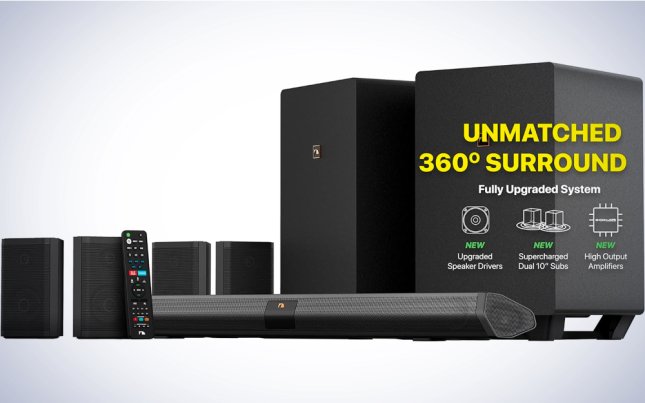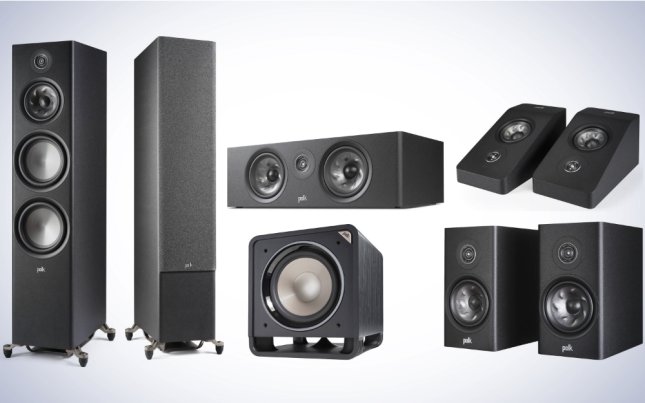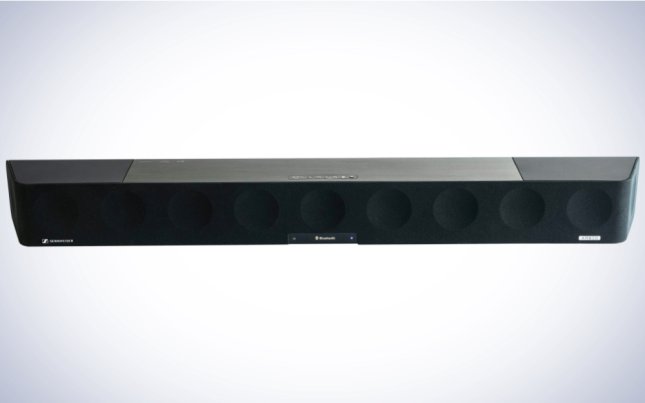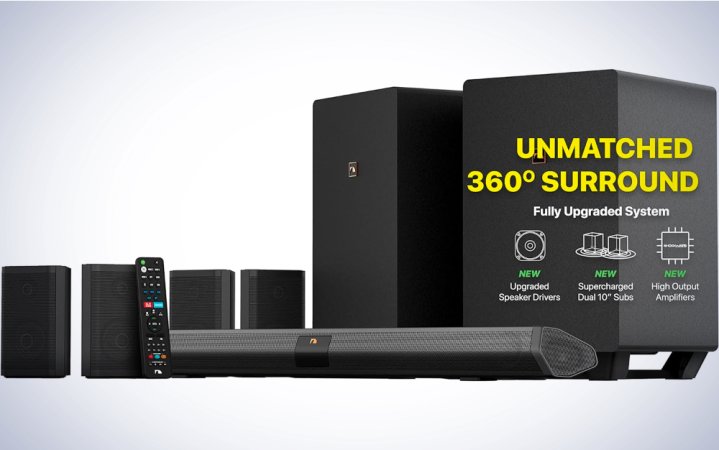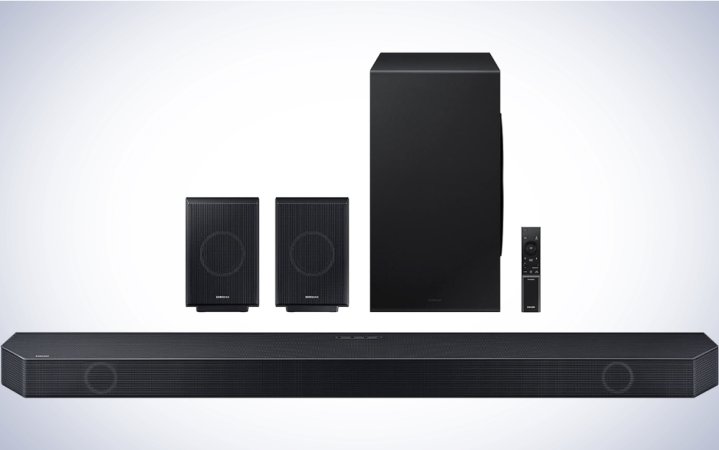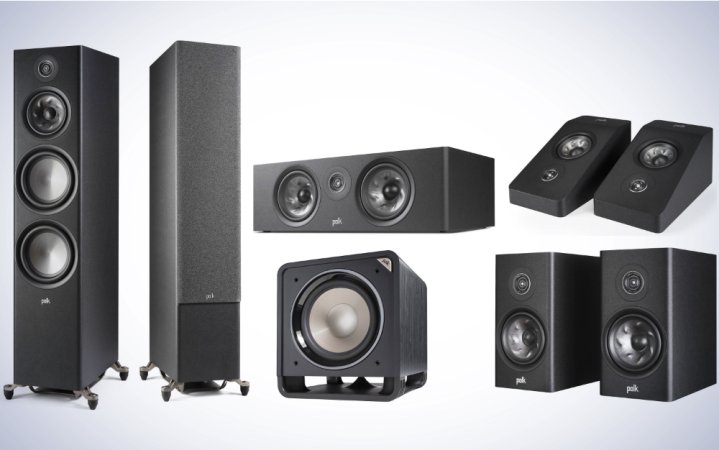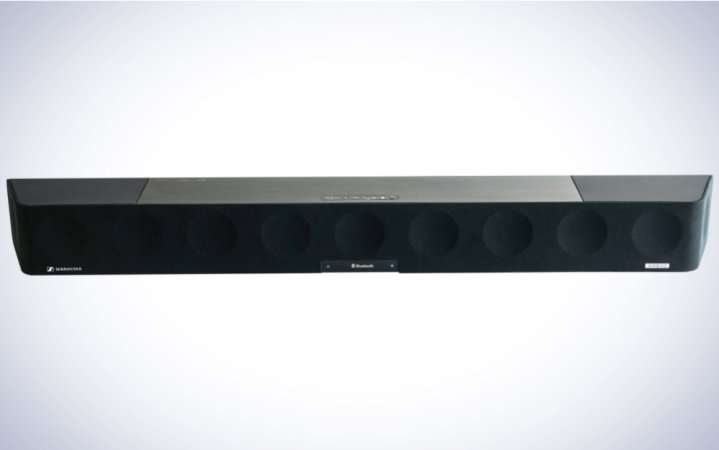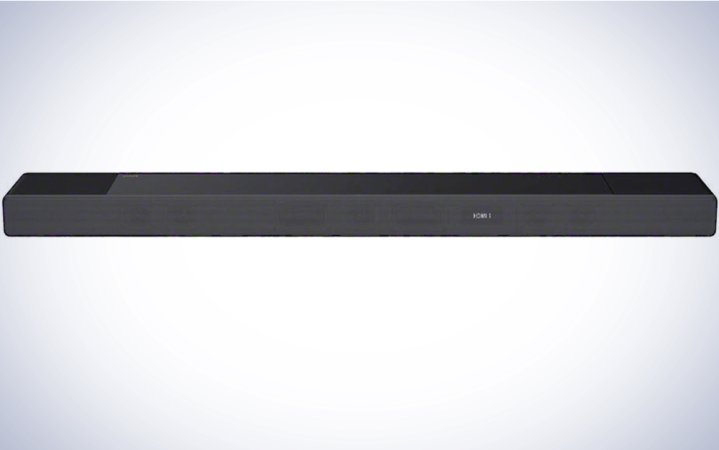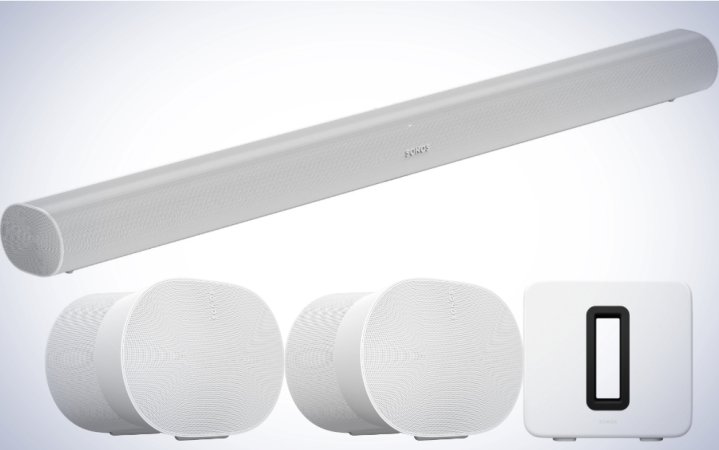We may earn revenue from the products available on this page and participate in affiliate programs. Learn more ›

With the way that TVs seem to get better and better every year for the same or a lower price, and with streaming services throwing theatrical releases and amazing, addictive series your way all the time, having a surround sound system is a nearly irresistible prospect. With today’s Dolby Atmos soundtracks that have a height dimension, sound effects move in 3D—from above and below, left and right, and in front or back—and having speakers that can reproduce those immersive elements makes home movie nights feel truly theatrical. However, while you could spend a fortune installing theater-style in-wall speakers into a dedicated theater room, you don’t have to in order to enjoy high-end height-based immersive sound. You can get good quality results even from a standalone soundbar or take progressive steps up to larger soundbar-based wireless systems or wired hi-fi speaker systems. Each variety is represented in our picks for the best surround sound systems, a group that meets different for movies, video games, and music in a range of sizes and prices.
- Best overall: Nakamichi Shockwafe Ultra 9.2.4 eARC/SSE Max
- Best wireless: Samsung Q990C
- Best wired: Polk Audio Reserve Dolby Atmos Speaker Bundle
- Best for TV: Sennheiser AMBEO Soundbar Max 5.1.4 channel
- Best for gamers: Sony HT-A7000
- Best for music: Sonos Ultimate Immersive Set with Arc
- Best in-wall: KEF Ci R Series
How we chose the best surround sound systems
In choosing the best surround systems in 2024, we considered at least a hundred or more options. Every good TV needs a surround sound speaker companion, but not everyone’s space, budget, and tech preferences are the same. So we wanted to include a variety that runs the gamut from single soundbars to large, opulent wired speakers—both freestanding and in-wall units. In between are some excellent soundbar-based surround systems that connect wirelessly to subwoofers and rear surround speakers. While watching movies and TV is the principal pastime for surround sound system users, we also included some systems that offer special nods to gaming and music listening.
These recommendations result from a combination of first-hand experience from either the author or other PopSci writers and editors, as well as pouring over specs, credible product reviews, and user feedback.
The best surround sound systems: Reviews & Recommendations
The best surround sound systems in 2024 support Dolby Atmos. There, we said it. Of course, not everyone uses Dolby Atmos or even knows about it yet. And there are other fine 3D object-oriented immersive audio formats like DTS:X and Sony 360 Reality Audio. (Many, though not all, of the best surround sound systems support those, too.) Dolby Atmos viewing material is not as pervasive or easy to access yet as it could or should be, but its availability and popularity are still expanding at a good clip. And immersive surround sound with a height dimension (which sends audio elements up and down, as well as left to right and front to back) is not just hype; it’s actually a better listening experience that most people recognize and appreciate once they hear the difference.
With all that said, different surround sound systems support Dolby and other surround formats in different ways. Most of them use up-firing speaker drivers to send sound waves up and bouncing off ceilings, while standalone soundbars also have side-firing drivers to bounce sound off of walls and other processing to create virtual surround effects. Deluxe “architectural” speaker systems install in-wall speakers and in-ceiling speakers that help the height-associated sounds—the most authentic and expensive way to buy into Dolby Atmos sound.
Best overall: Nakamichi Shockwafe Ultra 9.2.4 eARC/SSE Max
Specs
- Audio channels: 9.2.4 with 18 total speaker drivers
- Total power/SPL loudness: 1300W/113dB
- Frequency response: 20Hz-22kHz
- Connectivity: HDMI 2.1 input x3, HDMI 2.1 eARC output x1, optical digital audio input x3, coaxial audio input x1, RCA audio input x1, USB, Bluetooth 5.0 aptX HD
- Format compatibility: Dolby Vision with 4K HDR, Dolby Atmos, DTS:X
Pros
- Exceptional audio processing improves the playback of immersive Dolby Atmos and DTS:X sound
- Sound is loud, clear, and realistically detailed across the audio spectrum
- Three HDMI 2.1 ports and HDMI eARC output for the latest TVs and game consoles
Cons
- Extra speakers need extra space and power outlets
- No auto-calibration for tailoring speaker response to your space
- No Wi-Fi connectivity
Nakamichi’s Shockwafe systems have become perennial favorites for home wireless surround sound for their clear and realistic reproduction of immersive audio. The deluxe Shockwafe Ultra 9.2.4 eARC SSE Max represents the pick of the litter from the brand’s Shockwafe catalog and comes in at an MSRP of $1,899. For that, you get high-spec hardware and Nakamichi’s best audio processing technology for turning anything you watch into a theatrical experience.
The system’s HDMI 2.1 connections and eARC to the TV enable the highest quality lossless audio, 4K HDR, and Dolby Vision video, while variable refresh rate (VRR) smoothes out video game motion for gamers using next-gen consoles. Nakamichi’s SSE Max technology refers to the system’s three Spatial Surround Elevation audio processing engines, which work together to expand the soundstage’s sense of spaciousness, balance the surround-sound mix across all the speakers, and create the immersive dimension of height when playing object-oriented audio formats like DTS:X and Dolby Atmos.
The Shockwafe Ultra 9.2.4 eARC SSE Max comes with a lot of speakers—four surround satellites and twin 10-inch powered subwoofers in addition to the soundbar—and they all feature upgraded hardware. In the soundbar, you’ll find redesigned extended-range twin-cone drivers, and the 2nd-generation two-way Quad Modular Surround Speakers also have extended-range twin-cone drivers, as well as new silk dome tweeters. Meanwhile, the system produces massive bass rumble that you can feel in your gut due to the dual subwoofers with new high-output amplifiers and upgraded drivers.
Setting up the numerous speakers will take a fair amount of space and power outlets, but the product documentation recommends six different speaker layout options for you to choose from based on your space and preferences. A backlit remote also lets you pick from three SSE soundscape presets, along with other EQ and channel controls.
This system includes Bluetooth with Qualcomm aptX HD for wireless audio from other devices, a nice addition for music lovers who can stream audio at up to 24-bit digital quality. In all, the loud, detailed immersive audio and unique features of the Shockwafe Ultra 9.2.4 eARC SSE Max continue to make it an easy recommendation—the best surround sound system for making your living room a home theater.
Best wireless: Samsung Q990C
Specs
- Audio channels: 11.1.4 with 22 total speaker drivers
- Total power: 656W
- Frequency response: N/A
- Connectivity: HDMI input x2, HDMI output with eARC, optical digital audio input Bluetooth 5.0, dual-band Wi-Fi, Apple Airplay 2, Spotify Connect, Tidal Connect, Samsung SmartThings, Amazon Alexa voice assistant
- Format compatibility: Dolby Atmos, DTS:X, Dolby TrueHD, Dolby Digital Plus
Pros
- Crisp AVA voice reproduction makes voices easier to understand
- Certain Samsung TV users can get wireless Dolby Atmos without an HDMI cable, and other features
- Excellent overall sound quality featuring satellite speakers with up- and side-firing drivers
- Easy setup
Cons
- Some key features tied to Samsung TVs
The Samsung Q990C measures up as one of the best surround sound systems we experienced in 2023, particularly because it offers some choice innovative features when paired with flagship Samsung TV models. Specifically, the Q990C will operate without an HDMI cable connected—even for Dolby Atmos audio—when synced to 2023 Samsung TVs from the CU7000 budget-priced series and higher. Not only that, but the Q-Symphony technology syncs the Q990C’s audio to the speakers of compatible Samsung TVs from 2020 to the present, so the Q990C integrates the TV’s speakers into the overall surround sound profile. Lastly, the SpaceFit Sound Pro room-calibration system analyzes your space to optimize the audio mix and works with 2023 Samsung QLED and OLED TVs.
Even for non-Samsung TV owners, the Q990C’s design and technology make it one of the most appealing wireless surround sound systems. Its soundbar, subwoofer, and two satellites all connect wirelessly and feature four total up-firing drivers for handling the height effects of object-oriented immersive audio formats, such as DTS:X and Dolby Atmos. The rear satellite units fire from three directions—front, top, and side—to envelop you even more in sound. Gamers on the latest-gen. PS5 and Xbox Series X consoles can enjoy the 3D-optimized sound of the Game Mode Pro. And the AVA (Active Voice Amplifier) technology addresses the well-known problem of dialogue being muffled or otherwise lost in the surround sound mix by emphasizing onscreen voices.
With the Q990C, it’s easy to set up and get going listening to an excellent-sounding soundbar system, whether from the TV, Bluetooth 5.0, or WiFi connections like AirPlay 2. It pumps out hefty bass without overpowering the rest of the mix, and conveys dynamic levels well without your constantly needing to adjust the volume. Also, Adaptive Sound technology purports to keep the sound as detailed as possible, even at low volumes. As a final kicker, the built-in Amazon Alexa functionality not only provides voice control but also supports Alexa device grouping, making multi-room audio possible.
Best wired: Polk Audio Reserve Dolby Atmos Speaker Bundle
Specs
- Audio channels: 5.1.2-channel with height speakers for Dolby Atmos
- Total power/SPL loudness: N/A
- Frequency response: 28Hz-39kHz
- Connectivity: Wired (A/V receiver not included)
- Format compatibility: Dolby Atmos
Pros
- Audiophile-grade sound
- High-end hardware kicked down from Polk’s Legend series
- Top-firing height channels for Dolby Atmos immersive sound
- Classy finishes and high-end build quality
Cons
- AV receiver not included
- Considerable price
When you want the look, feel, and, most importantly, the audiophile-grade sound of a classic hi-fi system with floor-standing speakers, it’s hard to go wrong with the sleek style and pristine sound of Polk Audio Reserve series. Yet opting for a wired system of separate speaker components doesn’t mean you have to live in the past, as the Reserve Dolby Atmos Speaker Bundle includes two R900 up-firing speaker modules with rubber pads for sitting atop the powerful, three-way R700 floor-standing speakers, assuring that as long as you pair the system with a powerful, versatile A/V receiver, you can enjoy the height dimensions of immersive audio formats like DTS:X and Dolby Atmos.
The system also includes an excellent R400 center-channel speaker, sized appropriately for placement just below your TV or projector screen. This package doesn’t skimp on the rear-channel surround speakers either. The dual R200 satellite speakers for the rear channels could easily stand on their own as high-quality bookshelf speakers. Rounding out the system is the formidable and weighty (just under 50 pounds) HTS 12 subwoofer, which delivers punchy bass from its 12-inch front-firing woofer.
Polk’s Reserve series speakers feature some of the respected company’s best hardware. For example, the speakers (besides the subwoofer) utilize the next-generation Turbine cone for their midrange/bass drivers and Pinnacle ring radiator tweeter, carried over from Polk’s flagship Legend series. Also from the Legend series, the floor-standing units have Polk’s patented down-firing Power Port 2.0 designed to reduce noise from the bass response.
And that’s just one of the many brands—from consumer favorites Klipsch to audiophile favorites Focal to innovators Definitive Audio (who put powered subwoofers and hidden ports for upfiring modules in their expansive-sounding flagship bipolar floorstanders)—that have Atmos-enabled or height topper-compatible towers, etc. You can spend several hundred to many, many (many) thousands, depending on the setup. This all translates to dynamic and expressive, full-range and immersive sound for bringing a higher level of impact and realism to your home entertainment space. A surround sound system like this also deserves one of the best AV receivers of 2023 to power it, and while you’re at it, check out the best speaker wire options as well.
Best for TV: Sennheiser AMEBO Soundbar Max 5.1.4 channel
Specs
- Audio channels: 5.1.4 with 13 total speakers and class D amplifiers
- Total power/SPL loudness: 500W
- Frequency response: 30Hz-20kHz
- Connectivity: HDMI input x3, HDMI 2.1 eARC output, Tousling optical digital audio input, RCA analog audio input, Ethernet, Bluetooth 4.2, dual-band Wi-Fi, Airplay 2, Chromecast, Spotify Connect, Tidal Connect,
- Format compatibility: Dolby Atmos, DTS:X, MPEG-H Audio, Sony 360 Reality Audio, Dolby Vision
Pros
- Best virtual Dolby Atmos effects of any standalone soundbar
- Substantial built-in bass woofers can be fortified with an optional subwoofer
- Compatible with many immersive audio formats and high-resolution Wi-Fi standards
Cons
- No way to expand with satellite speakers
- Costs as much or more than many full surround sound systems
Perhaps the most ambitious of all soundbars, the Sennheiser AMBEO Soundbar Max attempts what few, if any, other soundbars do: to adequately fulfill your immersive surround sound needs within a single unit—no subwoofers or satellite speakers needed.
Through the technological feats of room calibration combined with its own immersive audio virtualization, the AMBEO Soundbar Max impressively approximates the height-dimensional movement of Dolby Atmos and other object-oriented audio formats better than any other single soundbar we’ve heard. And with six long-throw woofers packed inside, it achieves a rumbly bass response reaching 30Hz. All that engineering does come at a premium price, as even the recent sale price of the AMBEO Soundbar Max costs about the same as the entire Nakamichi Shockwafe Ultra 9.2.4 eARC SSE Max system above.
The AMBEO Soundbar Max is also a remarkably large soundbar, at 49.8 inches wide and a whopping 40.8 pounds. It needs a long surface to fit under a TV, and that TV needs to sit on a tall stand/legs or a riser. But without any extra speakers and cords and plugs required, setting it up is simple. Its AMBEO OS control system, which works either with a mobile app or through a web browser, makes setup even easier, walking you through the room calibration and controlling options like the built-in EQ and three bespoke AMBEO 3D modes.
While the AMBEO Soundbar Max is the most comprehensive surround sound system inside a single soundbar and is the best one-unit speaker companion for your TV, it cannot and does not best the performance of multi-speaker systems with a dedicated subwoofer and physical rear-channel speakers. However, we found first-hand that it represents the best-case scenario for people who want a terrific surround sound experience within the convenience and space-saving tidiness of a single unit.
Best for gamers: Sony HT-A7000
Specs
- Audio channels: 7.1.2-channel with 11 total amplifiers
- Total power/SPL loudness: 500W
- Frequency response: N/A
- Connectivity: HDMI 2.1 inputs w/8K passthrough x2, optical audio, analog audio, USB, Bluetooth 5.0, WiFi, AirPlay 2, Chromecast, Spotify Connect, Amazon Alexa, Google Assistant
- Format compatibility: Dolby Atmos, DTS:X, Sony 360 Reality Audio,
Pros
- HDMI 2.1 w/8K passthrough or 4K/120Hz refresh rate
- Impressive virtual Atmos with up- and side-firing speakers
- Decent bass for a standalone soundbar
- WiFi with good compatibility for streaming protocols
Cons
- The compatible wireless add-on speakers are pricey
- Exclusive gaming features only work with a PS5 and Bravia XR TV
The Sony HT-A7000 is one of the absolute best Dolby Atmos soundbars, but it also appeals directly to video game fanatics, as it supports 8K passthrough or 4K with a 120Hz refresh rate with support for Dolby Vision and HDR10, plus VRR and ALLM—perfect for squeezing the best graphic performance out of the latest-generation gaming consoles. Particularly if you keep everything within the Sony universe by connecting a PS5 console with a Sony Bravia XR TV, you’ll get Auto HDR Tone Mapping and Auto Genre Picture mode, which optimize colors and details and maximize responsiveness. Also, when paired with a Bravia XR, the HT-A7000 incorporates the TV’s speakers into the center channel of the surround sound mix (“Acoustic Center Sync”) and shows the soundbar’s controls on the TV screen.
You don’t need other Sony gear to enjoy the HT-A7000, as its side- and up-firing speakers create a very spacious soundstage both for immersive surround-sound formats like Dolby Atmos, DTS:X, and 360 Reality Audio or when converting other audio material to virtual 3D sound. On its own, it’s powerful enough to fill most living rooms with swirling sound, and its built-in subwoofer at least improves upon the bass response of a TV, as well as many other standalone soundbars. However, to build it out into a complete—and completely awesome—surround sound system, add the Sony SA-RS3S wireless rear speakers and one of the compatible wireless subwoofers like the Sony SA-SW5.
Besides its lovely, rich, detailed sound and gamer appeal, the HT-A7000 includes nearly the full rundown of tech standards, including Bluetooth 5.0, WiFi with AirPlay 2 and Chromecast, voice control from Alexa or Google Assistant and even good old-fashioned audio inputs and USB for audio file playback.
Best for music: Sonos Ultimate Immersive Set with Arc
Specs
- Audio channels: 7.1.4
- Total power/SPL loudness: N/A
- Frequency response: N/A
- Connectivity: HDMI eARC, WiFi, Ethernet
- Format compatibility: Multiroom audio, Dolby Atmos, Dolby TrueHD, Apple AirPlay 2, Tidal Connect, Spotify Connect, Siri, Amazon Alexa, Google Assistant
Pros
- Smart speaker features and WiFi streaming
- Impressive surround sound imaging
- Sleek styling with touch controls on the soundbar and Era 300 surround speakers
- Best option for spatial audio music with multi-room options
Cons
- No HDMI inputs
- Room calibration only works with the iOS app
- Best Apple Music spatial audio experience requires an Apple TV 4K hub
Enjoying big-budget movies and streaming shows with object-oriented sound effects flying all around you in every direction is a lot of fun, and also the most common reason that people invest in Atmos-ready surround sound systems. However, these systems that cost a sizable investment can also provide great music-listening experiences for the growing cache of Spatial Audio available on apps such as Tidal, Amazon Music, and Apple Music. Of those three, the last one currently has the largest selection of immersive spatial audio music, and Sonos systems provide the best gateway to listening to them.
Of the many Sonos configurations for home theater and spatial audio music, the Ultimate Immersive Set with Arc rules the roost with the most power and the most sophisticated rear channel speakers. The connected, WiFi-enabled system is based around the premium Arc soundbar, which is a 5.0.2 array capable of virtual surround sound on its own, but the complete package adds the rich, smooth, and booming bass of Sonos’ best subwoofer, the Sub (Gen 3), and two Era 300 smart speakers as rear surround satellites. This transforms it into a truly multidirectional, multidimensional 7.1.4 system.
The Ultimate Immersive Set will already set you back more than $2,000, but there’s more to buy to get the best decoding of Apple Music spatial audio. Best results come from hooking up the Arc soundbar’s HDMI eARC to a TV connected to an Apple TV 4K. And while mixing music for Atmos or other spatial audio formats remains a nascent art, and a fair percentage of that music is mixed rather poorly, when the source music is done well, listening to it through the Ultimate Immersive Set decoded through the Apple TV 4K sounds positively transcendent, with up-firing drivers on both the soundbar and Era 300 satellites. And to boot, music lovers will have a top-shelf Atmos-ready surround sound system with plenty of technological goodies thrown in.
For instance, Sonos includes its own voice control system (“Hey Sonos …”) and also works with Alexa and Google Assistant. Built-in processing emphasizes the clear communication of onscreen dialog, controlled from the Sonos S2 app. That app for iOS or Android also handles other types of control and setting up multi-room audio if you choose to add more Sonos speakers to your household. The app includes room calibration for optimizing the speakers’ output to your space, but currently, that only works on iOS. Also, the app functions as an audio hub with its own Sonos Radio service and for bringing in your other streaming audio subscriptions, such as Spotify, Apple Music, Audible, etc.
Best in-wall: KEF Ci R Series
Specs
- Audio channels: Varies depending on configuration
- Total power/SPL loudness: Varies depending on configuration
- Frequency response: 40Hz-28kHz
- Connectivity: Wired (A/V receiver not included)
- Format compatibility: THX Certified Ultra
Pros
- Amazing, pristine sound
- Provides true Atmos sound with overhead speakers
- Keeps cables and large speakers out of the living space
Cons
- Quite expensive
- Requires laborious architectural installation
To make a truly inclusive list of best surround sound systems, in-wall speakers have to be there, even though they are a special case for the rare enthusiast with both the considerable budget to afford them and the space and will to have them installed. So whether you’re a real tycoon or a hopeful conceive/believe/achiever, in-wall surround sound systems bestow all the benefits of high-end audio (there really are no low-grade options) with the luxurious aesthetics of keeping the speakers and their wirings out of your space. Also, for Atmos or immersive audio sticklers, the most authentic way to integrate Atmos into a home theater system is to mount overhead speakers above you. With in-wall—and also, in this case, in-ceiling—speakers, you can have the true Atmos glory in a visually clean way, with the speakers flush to surfaces.
As far as which brand to choose, KEF makes some of the best bookshelf and powered speakers in the world and makes products of the highest quality delivering a wide sweet spot from compact enclosures. The KEF Ci R series of in-wall speakers are THX-certified for home theater and include the 12th-generation Uni-Q driver array, featuring the tweeter at the acoustic centre of the bass/midrange cone for coherence and even dispersion, all backed by KEF’s Metamaterial Absorption Technology (MAT), which the company claims to absorb 99 percent of unwanted sound from the cabinets to reduce distortion and coloration.
Configurations can vary according to the user’s preferences but will likely include the KEF Ci5160RL-THX for the left and right channels and the Ci3160RL-THX for the center channels. Those units retail for about $3,000 and $2,000 respectively, and believe it or not, they are bargains compared to KEF’s analogous Ci-Reference series units, the Ci5160REFM-THX and Ci3160REFM-THX, which retail for about $11,000 and $8,000 respectively. In-ceiling speakers would likely be the Ci200RS-THX for about $1,000 a pop. All of the Ci R series in-wall speakers feature KEF’s distinctive aluminum-dome drivers and machined aluminum baffles.
While this series doesn’t include a subwoofer, since those are typically not in-wall configurations, one cannot splurge this much on a home theater without rounding it out with some high-quality low-end rumble. The KEF KF92 1000W powered subwoofer with twin 9-inch drivers in a compact enclosure to tuck away in a corner should do nicely, while the KEF KC62 with a dual 6-inch force-cancelling driver setup is even more cabinet-friendly. And nobody says you can only have one (though we recommend matching pairs)!
What to consider when shopping for the best surround sound system
There are many factors that determine which surround sound system is best for your situation. Below you’ll find the ones we considered most important when determining which to feature in this story.
Size of room
You cannot bargain with the physical constraint of the room for your surround sound system. If your space is too small to accommodate a large, multi-piece system like the Polk Audio Reserve Dolby Atmos Speaker Bundle, you cannot shoehorn it simply because you want to. The same goes for a space that may be too large to get the resulting sound you want from a single sound bar. Be realistic about the amount of audio output power and number of speakers your home theater space needs or can accommodate.
Also, single sound bars like the AMBEO Soundbar Max, the Sony HT-A7000, or Sonos Arc—if purchased as standalone units—rely on traditionally sized, generally rectangle or square rooms to bounce sound waves off of the ceiling and walls to create virtual surround sound and height-based Atmos effects from a single unit. The more abnormally shaped your space is, meaning a very high or angled ceiling and/or a very large and open floor space, the less you can get away with virtual surround sound from a single sound bar. If that’s the case, you’ll have better results from a multi-speaker setup like the Nakamichi Shockwafe Ultra 9.2.4 eARC/SSE Max or the Sonos Ultimate Immersive Set with Arc.
Budget
Second only to your physical space in terms of inflexibility may be the money you can spend or are willing to spend. Being the “best,” the surround sound systems profiled here don’t come cheap, starting at around $1,000 for the Sony HT-A7000 soundbar (if you get it at a discount), rising to just under $4,000 for the Polk Audio Reserve Dolby Atmos Speaker Bundle, and at least $10,000 plus custom installation costs for the ambitious KEF Ci R Series in-wall speakers. You can spend astonishingly more than that if you seek out the highest-end reference-grade speakers available. However, the median price for the systems on this list is less than $2,000, which is no small investment but worth it to those who value clear audio quality, powerful bass, and height-based audio formats like Dolby Atmos when relaxing at home.
Don’t despair, however, if your price range falls beneath the systems on offer here. The best budget surround sound systems still can provide thumping bass, and decent Dolby Atmos effects that will far outshine the performance of TV speakers or a pair of basic bookshelf speakers. For a well-regarded system that provides all of the above for perhaps the best value available, the Vizio M-Series M51ax-J6 is a surround system under $300 that includes a soundbar, subwoofer, two satellites, and virtual Dolby Atmos processing.
A/V receivers
While thinking about budget, also think about what add-ons or necessary accessories you’ll need along with the surround sound system. For example, when you opt for a system made up of wired speakers—and it’s not part of a bundle that includes an A/V receiver—you’ll have to purchase your own receiver.
Ensure that the A/V receiver has high enough video resolution pass-through for the TV you have or will have in the near future, whether that’s 4K, 8K, etc. Most A/V receivers on the market today will have 4K passthrough, and most of the best A/V receivers available have 8K capability.
Also important is having enough audio channels on the A/V receiver for the speaker system you buy, and perhaps having a few extra channels on the receiver to leave room for speaker expansion in the future. For example, the Polk Audio Reserve Dolby Atmos Speaker Bundle is a 5.1.2-channel system, so that the A/V receiver would need at least seven speaker channels plus a subwoofer output. The Denon AVR-X2800H or Sony STR-AN1000 could be a good starter choice, offering seven speaker channels, two subwoofer outputs, 8K HDMI, and it also includes Bluetooth and WiFi wireless streaming. While the Marantz Cinema 70S offers similar specs in a more low-profile, visually appealing form factor.
Subwoofers
Most of the systems here include at least one subwoofer, which usually is an essential component to a surround sound system in order to truly feel—not just hear—the meticulously crafted and mixed audio tracks in movies, TV shows, and music. In the case of the Sennheiser AMBEO Soundbar Max and the Sony HT-A7000, the onboard woofers provide a good bass response without a subwoofer but also accept expansion subwoofers to up the gut-shaking quotient. The HT-A7000 only works with compatible Sony units like the Sony SA-SW5, while the AMBEO will take a third-party woofer for extension and embellishment.
If you do have a desire for a subwoofer, two excellent entry-level choices are the Polk Audio PSW10 100W 10-inch subwoofer or for about twice the price, the more gargantuan BIC America Acoustech PL-200II 250W 12-inch subwoofer. And if you want musicality, not just raw muscularity, in your low-end reinforcement, the KEF Kube line adds rich dynamics and tight textures for closer to a grand. If you don’t have neighbors to worry about or space/budget constraints and you want to unleash a relentless response and unrestrainted transient energy, the SVS PB16-Ultra will test your foundations.
FAQs
Whether surround sound is better than stereo is a subjective question, depending on the source material. Most major-release movies and video games, as well as many streaming series or network TV shows are mixed for surround sound playback, and as a result have directional and spatial elements in the soundtrack intended for surround sound, which can include soundbars with virtual surround sound processing or full surround sound systems with left, right, center, left rear, and right rear channels. That being the case, surround sound can fairly be said to be better than stereo speakers for watching visual entertainment and playing video games.
A 5.1 surround sound system can be good for music, depending on the system itself and the music being played. Many 5.1 surround sound systems have Music modes that will adapt the speakers to playing stereo-mixed music and/or to “upmix” stereo music to be played in a simulated 5.1 surround sound mix. The upmixing settings can have mixed results, but there is also some amount of music you can find that has been mixed for 5.1 systems, which also may sound excellent or somewhat unnatural, depending on the source material.
Regardless of the variable circumstances, playing music on a 5.1 surround sound system is quite often a satisfying way to listen to music. Furthermore, because 5.1 systems have subwoofers, they will often be the most bass-heavy speakers in the household, which is often a great way to hear the music as the artists intended.
You can add more speakers to a surround sound system that is wired to an A/V receiver that has additional speaker outputs to be used. For packaged surround sound systems that use a soundbar for all the inputs and outputs or connect to additional speakers wirelessly, it’s less common for additional speakers to be allowed. However, that depends on each particular product. Certain other packaged surround sound systems use wired speakers connected to an A/V receiver included in the package; in that case, it also depends on whether the receiver has additional speaker outputs available.
Final thoughts on the best surround sound systems
- Best overall: Nakamichi Shockwafe Ultra 9.2.4 eARC/SSE Max
- Best wireless: Samsung Q990C
- Best wired: Polk Audio Reserve Dolby Atmos Speaker Bundle
- Best for TV: Sennheiser AMBEO Soundbar Max 5.1.4 channel
- Best for gamers: Sony HT-A7000
- Best for music: Sonos Ultimate Immersive Set with Arc
- Best in-wall: KEF Ci R Series
It’s always a good time to get into surround sound, but 2023 was a particularly good year because support for Dolby Atmos and other object-based surround-sound formats, both in terms of speaker systems and media availability, is really heating up. You can get in on this fun even if you only have the space and budget for a single soundbar. To keep things easy while expanding the soundstage, wireless surround sound systems use the soundbar to make all the corded or wireless connections between the TV and other devices like gaming consoles and the main speakers, subwoofer, and surround speakers. Meanwhile, wired surround sound systems require a separate AV receiver to connect to the speakers and a TV, but they can be some of the most luxurious and immaculate-sounding systems you’ll find.
With all that to consider, if you stay practical and choose a surround sound system that makes sense for your space, budget, and desired level of complexity, you’ll be enjoying home theater like never before in not only 2024 but for many years to come.
